5 Yoga Poses for Relieving Lower Back Pain
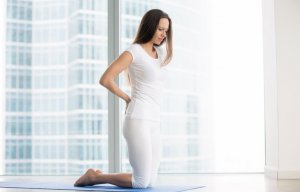
If there’s an area in which human beings tend to develop pain, it’s the lower back. It’s due to sitting down or standing for a long time, deterioration, lack of lubrication in the joints, or other reasons. Nonetheless, it’s usually a very annoying ailment that can sometimes prevent us from performing certain tasks correctly.
Yoga won’t only be a great relief for back pain, it will also make you connect with yourself. Additionally, it will relax you and noticeably change your energies throughout the day. If you’ve never done yoga, your time has come! We’ll share five yoga poses for relieving lower back pain!
1. Salamba bhujangasana
This pose, written in Sanskrit: salamba bhujangasana, is a fairly accessible posture for anyone. That is, you don’t need to be extremely flexible or have a lot of resistance to carry it out.
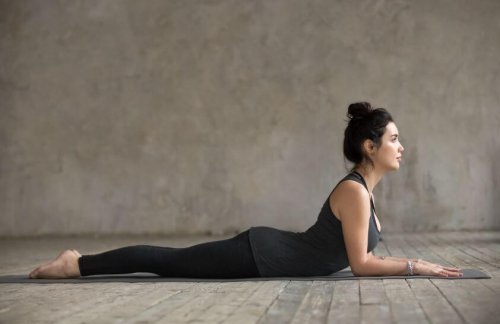
This yoga pose is also called sphinx pose. In this position, you stretch the spine and stimulate the abdominal muscles to improve your overall circulation. More importantly, it rejuvenates and releases tension in the lower back.
The execution of the sphinx pose is very simple. Firstly, stretch out, face down with your belly resting on the floor. Place your hands below your shoulder and push to hold your chest up with your forearms on the floor. You should look forward and keep your shoulders relaxed and lowered, creating space in the neck.
2. Supta matsyendrasana
Supta matsyendrasana translates from Sanskrit as “the supine lord of the fish”. In English, we call it a “supine spinal twist” and it’s a highly recommendable yoga pose for stretching the back and relaxing the muscles.
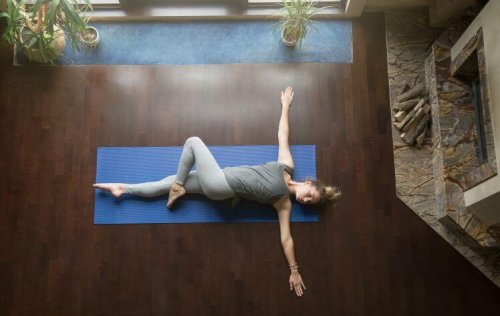
This position also helps reduce migraines, releases stress, and oxygenates muscles. To put it into practice, lie on your back and bend your right knee to your chest. Place your left hand on the right knee and apply some pressure towards the ground. The other leg should be stretched and the other arm to the side, simulating a “T” shape.
3. Marjaryasana-bitilasana
The cat and cow pose or marjaryasana-bitilasana is a combination of two basic poses in any yoga school. This position gives flexibility to your back and prepares you for more difficult poses.
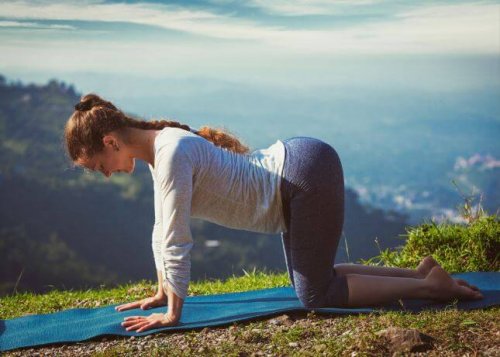
The cat and cow pose gives strength to the arms and wrists. They also tone the trunk, stretch the neck, and help achieve better balance. To do this yoga posture, you must be on your knees and rest your hands firmly on the ground, just underneath your shoulders. Start with the position of the cow, making an arch with your back and pushing your abdomen as low as you can. Now shift to the cat pose by bending your back upward.
4. Adho mukha svanasana
This pose is representative of yoga since it’s part of a “sun salutation”. It’s the downward dog pose or adho mukha svanasana and it reinforces the bones, legs, and wrists. Moreover, it aids brain oxygenation and relieves back pain.
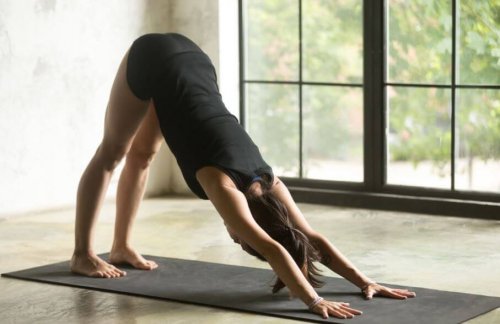
To perform this pose, open your feet to hip width apart and then place your hands on the ground at a considerable distance from the feet. Your body should form an inverted “V” shape, with your head facing down and trying your best to not lift the heels. At first, if you don’t have much flexibility, you can use a chair or stacked books to support yourself.
5. Balasana
Balasana or child’s pose is a very relaxing and comfortable yoga position. It’s said that this pose stimulates the third eye chakra, so if you want to connect with your spirituality don’t hesitate to execute this pose. Furthermore, it aligns the breathing with the functioning of the organs and helps to develop an introspection.
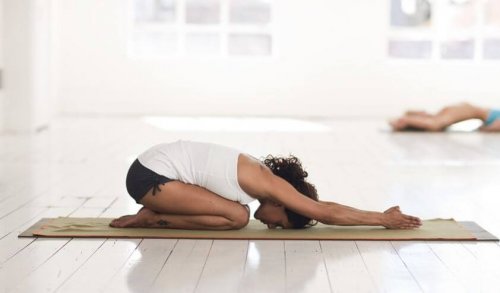
It’s very simple to do this pose. Sit on your heels and place your arms at your sides with the palms of your hands facing upwards. Now, lean your body forward until your forehead touches the ground and lie there.
Without a doubt, doing these yoga poses will lessen the pain and discomfort in your lower back. Additionally, these positions also stimulate other parts of the body, so you will gain by putting these yoga poses into practice. It’s important for you to do the poses on a yoga mat or a towel as it will be much more comfortable. It’s time to get rid of back pain!
If there’s an area in which human beings tend to develop pain, it’s the lower back. It’s due to sitting down or standing for a long time, deterioration, lack of lubrication in the joints, or other reasons. Nonetheless, it’s usually a very annoying ailment that can sometimes prevent us from performing certain tasks correctly.
Yoga won’t only be a great relief for back pain, it will also make you connect with yourself. Additionally, it will relax you and noticeably change your energies throughout the day. If you’ve never done yoga, your time has come! We’ll share five yoga poses for relieving lower back pain!
1. Salamba bhujangasana
This pose, written in Sanskrit: salamba bhujangasana, is a fairly accessible posture for anyone. That is, you don’t need to be extremely flexible or have a lot of resistance to carry it out.

This yoga pose is also called sphinx pose. In this position, you stretch the spine and stimulate the abdominal muscles to improve your overall circulation. More importantly, it rejuvenates and releases tension in the lower back.
The execution of the sphinx pose is very simple. Firstly, stretch out, face down with your belly resting on the floor. Place your hands below your shoulder and push to hold your chest up with your forearms on the floor. You should look forward and keep your shoulders relaxed and lowered, creating space in the neck.
2. Supta matsyendrasana
Supta matsyendrasana translates from Sanskrit as “the supine lord of the fish”. In English, we call it a “supine spinal twist” and it’s a highly recommendable yoga pose for stretching the back and relaxing the muscles.

This position also helps reduce migraines, releases stress, and oxygenates muscles. To put it into practice, lie on your back and bend your right knee to your chest. Place your left hand on the right knee and apply some pressure towards the ground. The other leg should be stretched and the other arm to the side, simulating a “T” shape.
3. Marjaryasana-bitilasana
The cat and cow pose or marjaryasana-bitilasana is a combination of two basic poses in any yoga school. This position gives flexibility to your back and prepares you for more difficult poses.

The cat and cow pose gives strength to the arms and wrists. They also tone the trunk, stretch the neck, and help achieve better balance. To do this yoga posture, you must be on your knees and rest your hands firmly on the ground, just underneath your shoulders. Start with the position of the cow, making an arch with your back and pushing your abdomen as low as you can. Now shift to the cat pose by bending your back upward.
4. Adho mukha svanasana
This pose is representative of yoga since it’s part of a “sun salutation”. It’s the downward dog pose or adho mukha svanasana and it reinforces the bones, legs, and wrists. Moreover, it aids brain oxygenation and relieves back pain.

To perform this pose, open your feet to hip width apart and then place your hands on the ground at a considerable distance from the feet. Your body should form an inverted “V” shape, with your head facing down and trying your best to not lift the heels. At first, if you don’t have much flexibility, you can use a chair or stacked books to support yourself.
5. Balasana
Balasana or child’s pose is a very relaxing and comfortable yoga position. It’s said that this pose stimulates the third eye chakra, so if you want to connect with your spirituality don’t hesitate to execute this pose. Furthermore, it aligns the breathing with the functioning of the organs and helps to develop an introspection.

It’s very simple to do this pose. Sit on your heels and place your arms at your sides with the palms of your hands facing upwards. Now, lean your body forward until your forehead touches the ground and lie there.
Without a doubt, doing these yoga poses will lessen the pain and discomfort in your lower back. Additionally, these positions also stimulate other parts of the body, so you will gain by putting these yoga poses into practice. It’s important for you to do the poses on a yoga mat or a towel as it will be much more comfortable. It’s time to get rid of back pain!
All cited sources were thoroughly reviewed by our team to ensure their quality, reliability, currency, and validity. The bibliography of this article was considered reliable and of academic or scientific accuracy.
- Sherman, K. J., Cherkin, D. C., Wellman, R. D., Cook, A. J., Hawkes, R. J., Delaney, K., & Deyo, R. A. (2011). A randomized trial comparing yoga, stretching, and a self-care book for chronic low back pain. Archives of Internal Medicine, 171(22), 2019–2026. https://doi.org/10.1001/archinternmed.2011.524
- Williams, K. A., Petronis, J., Smith, D., Goodrich, D., Wu, J., Ravi, N., … Steinberg, L. (2005). Effect of Iyengar yoga therapy for chronic low back pain. Pain, 115(1–2), 107–117. https://doi.org/10.1016/j.pain.2005.02.016
- Sherman, K. J., Cherkin, D. C., Erro, J., Miglioretti, D. L., & Deyo, R. A. (2005). Comparing yoga, exercise, and a self-care book for chronic low back pain: A randomized, controlled trial. Annals of Internal Medicine, 143(12), 849–856. https://doi.org/10.7326/0003-4819-143-12-200512200-00003
- Sherman, K. J., Wellman, R. D., Cook, A. J., Cherkin, D. C., & Ceballos, R. M. (2013). Mediators of yoga and stretching for chronic low back pain. Evidence-Based Complementary and Alternative Medicine, 2013. https://doi.org/10.1155/2013/130818
This text is provided for informational purposes only and does not replace consultation with a professional. If in doubt, consult your specialist.








